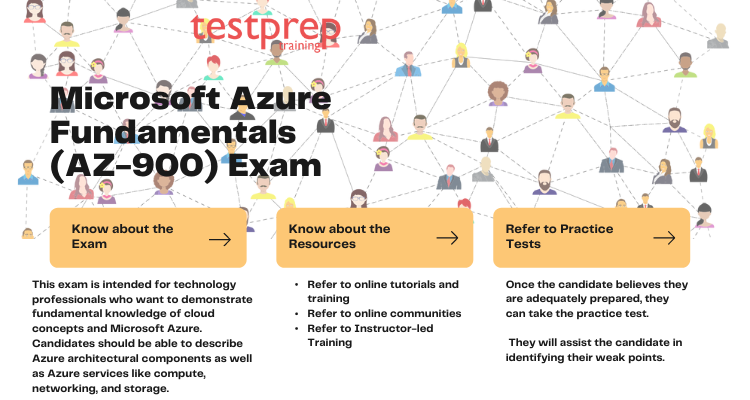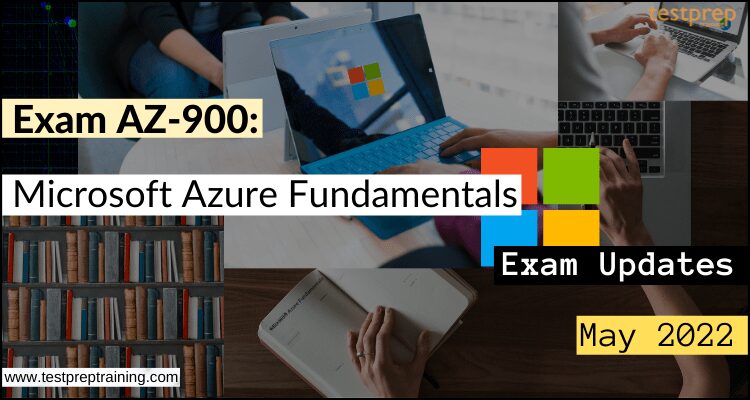We all are going to see updates in the English language version of the AZ-900 exam on May 5, 2022. Certainly, the Azure Fundamentals exam is an opportunity to prove knowledge of cloud concepts, so you must keep track of the latest changes. The first Azure certification exam is Microsoft AZ 900 and to earn this, you must first understand the fundamental aspects and benefits of Microsoft’s Cloud-like services, such as how subscriptions work, what support plans are available, the difference between Platform as a Service, Infrastructure as a Service, and Software as a Service, and which services you would use when. Let’s go through the AZ-900 Exam Updates of May 2022!
About AZ-900 Exam
This exam is intended for technology professionals who want to demonstrate fundamental knowledge of cloud concepts and Microsoft Azure. Candidates should be able to describe Azure architectural components as well as Azure services like compute, networking, and storage. Candidates should also be able to describe the features and tools used to secure, govern, and administer Azure.
This exam is 60 minutes long and does not include any simulated lab scenarios. Rather, it consists of multiple-choice questions with one or more correct answers, as well as some multi-part questions. This includes one main postulation and a few multiple-choice questions about the same scenario.
Let us now jump to the main point of the article –
Microsoft Azure Fundamentals Exam AZ-900 Updated Course Outline
Module 1 – Describe cloud concepts (25–30%)
The Microsoft Azure Fundamentals Exam cover the latest and updated exam guide including –
Describe cloud computing
- Define cloud computing (Microsoft Documentation: What is cloud computing? and Types of Cloud Computing)
- Describe the shared responsibility model (Microsoft Documentation: Shared Responsibility Model in Cloud)
- Define cloud models, including public, private, and hybrid (Microsoft Documentation: What is a Public Cloud?, What is a Private Cloud? and What is a Hybrid Cloud?)
- Identify appropriate use cases for each cloud model (Examples of cloud computing)
- Describe the consumption-based model (Microsoft Documentation: Consumption and Fixed Cost Models)
- Compare cloud pricing models (Microsoft Documentation: Azure Product Pricing and Azure Cloud Services pricing)
- Describe serverless
Describe the benefits of using cloud services (Benefits of Cloud Computing Services)
- Describe the benefits of high availability and scalability in the cloud (Microsoft Documentation: Benefits and considerations of using cloud services)
- Describe the benefits of reliability and predictability in the cloud (Microsoft Documentation: Azure Reliability and Overview of the reliability pillar)
- Describe the benefits of security and governance in the cloud (Microsoft Documentation: Security governance and Governance in the Microsoft Cloud and Azure governance documentation)
- Describe the benefits of manageability in the cloud (Microsoft Documentation: Cloud management in the Cloud Adoption Framework, Cloud management gateway overview and Azure Management Guide, Before you start)
Describe cloud service types
- Describe infrastructure as a service (IaaS) (Microsoft Documentation: What is IaaS? and Azure IaaS (infrastructure as a service)
- Describe platform as a service (PaaS) (Microsoft Documentation: What is PaaS? and Use platform as a service (PaaS) options)
- Describe software as a service (SaaS) (Microsoft Documentation: What is SaaS? and About SaaS)
- Identify appropriate use cases for each cloud service (IaaS, PaaS, SaaS) (Microsoft Documentation: Azure Cloud Services)
Module 2 – Describe Azure architecture and services (35–40%)
Describe the core architectural components of Azure
- Describe Azure regional, regional pairs, and sovereign regions (Microsoft Documentation: Azure Regions and Avaialbility Zones and Azure Regional Pairs and Azure Sovereign Clouds)
- Describe availability zones (Microsoft Documentation: Azure availability zones)
- Describe Azure datacenters (Microsoft Documentation: Datacenter security overview)
- Describe Azure resources and resource groups (Manage Azure resource groups)
- Describe subscriptions (Microsoft Documentation: Subscription decision guide and Azure subscription)
- Describe management groups (Microsoft Documentation: Azure Management Groups)
- Describe the hierarchy of resource groups, subscriptions, and management groups (Microsoft Documentation: What are Azure management groups? )
Describe Azure compute and networking services
- Compare compute types, including container instances, virtual machines, and functions (Choose an Azure compute service, Azure Container Instances, Introduction to Azure virtual machines, Introduction to Azure Functions)
- Describe Virtual Machine options, including Azure Virtual Machines, Azure Virtual Machine Scale Sets, availability sets, and Azure Virtual Desktop (Virtual machines in Azure, What are virtual machine scale sets? and What is Azure Virtual Desktop?)
- Describe resources required for virtual machines (Windows virtual machines in Azure)
- Describe application hosting options, including Web Apps, containers, and virtual machines
- Describe virtual networking, including the purpose of Azure Virtual Networks, Azure virtual subnets, peering, Azure DNS, Azure VPN Gateway, and Azure ExpressRoute (What is Azure Virtual Network?, Virtual Network Subnet, Azure Virtual Network Peering, Azure Peering Service Overview, What is Azure DNS?, What is Azure VPN Gateway?, Azure ExpressRoute and Significance of Azure ExpressRoute)
- Define public and private endpoints (What is a private endpoint?)
Describe Azure storage services
- Compare Azure storage services (Introduction to Azure Storage)
- Describe storage tiers (Storage account overview, Hot, Cool, and Archive access tiers)
- Describe redundancy options (Azure Storage redundancy)
- Describe storage account options and storage types (Storage account overview)
- Identify options for moving files, including AzCopy, Azure Storage Explorer, and Azure File Sync (azcopy copy, Get started with AzCopy, Transfer data with AzCopy and file storage, What is Azure File Sync?, Get started with Storage Explorer)
- Describe migration options, including Azure Migrate and Azure Data Box (About Azure Migrate)
Describe Azure identity, access, and security
- Describe directory services in Azure, including Azure Active Directory (Azure AD) and part of Microsoft Entra and Azure Active Directory Domain Services (Azure AD DS)
- Describe authentication methods in Azure, including single sign-on (SSO), multifactor authentication (MFA), and passwordless (Passwordless authentication options for Azure Active Directory, authentication and verification methods are available in Azure Active Directory)
- Describe external identities in Azure, including business-to-business (B2B) and business-to-customer (B2C)
- Describe Microsft Entra Conditional Access
- Describe Azure role-based access control (RBAC) (What is Azure role-based access control (Azure RBAC)?)
- Describe the concept of Zero Trust (What is Zero Trust?)
- Describe the purpose of the defense in-depth model
- Describe the purpose of Microsoft Defender for Cloud (What is Microsoft Defender for Cloud?)
Module 3 – Describe Azure management and governance (30–35%)
Describe cost management in Azure
- Describe factors that can affect costs in Azure (Plan and manage your Azure costs)
- Compare the Pricing calculator and the Total Cost of Ownership (TCO) calculator (Total Cost of Ownership (TCO) Calculator)
- Describe the Cost Management capabilities in Azure
- Describe the purpose of tags (Use tags to organize your Azure resources and management hierarchy)
Describe features and tools in Azure for governance and compliance
- Describe the purpose of Microsoft Purview in Azure
- Describe the purpose of Azure Policy (What is Azure Policy?)
- Describe the purpose of resource locks (Lock resources to prevent unexpected changes)
Describe features and tools for managing and deploying Azure resources
- Describe the Azure portal (Azure portal overview)
- Describe Azure Cloud Shell, including Azure Command-Line Interface (CLI) and Azure PowerShell (Overview of Azure Cloud Shell)
- Describe the purpose of Azure Arc (Azure Arc overview)
- Describe infrastructure as code (IaC) (IaC on Azure)
- Describe Azure Resource Manager (ARM) and ARM templates (What is Azure Resource Manager?, What are ARM templates?)
Describe monitoring tools in Azure
- Describe the purpose of Azure Advisor (Introduction to Azure Advisor)
- Describe Azure Service Health (What is Azure Service Health?)
- Describe Azure Monitor, including Log Analytics, Azure Monitor alerts, and Application Insights (Log Analytics tutorial, Azure Monitor overview, Application Insights overview)
Exam Results
The outcome is announced immediately following your exam. The score is displayed, and you can see whether or not you passed the exam. To qualify for this AZ – 900, you must have a score of 700 or higher. There are no prizes or rewards for the highest scorer. So there’s no point in comparing your score to others. Because each candidate is given a random subset of the questions and the exams are constantly fine-tuned.
Let us now have a look at some resources that will help you ace the exam –

1. Microsoft Learning Platform
The main portal merely serves as a command center for all Microsoft exams and certifications. On the Microsoft Learning Page, you can find a list of all Microsoft certifications. As a result, you will have an easier time searching. So, before anything else, this should be your starting point for AZ-900 exam preparation. This is because everything you need to know about the exam can be found there. This includes exam registration, links to AZ-900 Microsoft Azure Fundamentals, information on AZ-900 exam modules, prerequisites, exam study groups, links to exam policies and exam structure, and so on. Furthermore, this is one of the few places where you’ll find all of the important updates regarding the exam schedule, pricing changes, and so on.
2. Microsoft Documentation
Don’t get this page mixed up with Microsoft’s Learning portal. Because each of these sections has its learning page. You can easily find the page dedicated to Azure Fundamentals in Microsoft Azure Documentation. You can also learn about concepts like Agility, Disaster Recovery, Elasticity, Fault Tolerance, High Availability, and Scalability, which are critical in any cloud ecosystem. As a result, you’ll learn how to compare and contrast basic Azure cloud migration steps from this point forward.
3. Forums & Study Groups
You should be aware of the Azure role-based exam study groups and forums available in the Microsoft Learning portal. Unfortunately, this facility is not available for the AZ-900 exam. There are, however, other popular forums for the same. As a result, you can leave your queries and questions there and answer those that you are familiar with. Because many experienced and knowledgeable people can easily answer your questions.
4. Evaluate yourself with Practice Test
Sample tests are always helpful in preparing for any exam you’re about to take. Even though there are no sample tests available on Microsoft’s official website; however, for the AZ-900, there are numerous practice tests available at TestPrepTraining.com.


